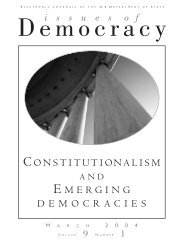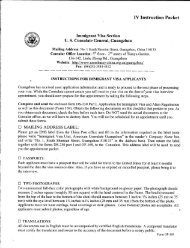s. history us history us history - Embassy of the United States
s. history us history us history - Embassy of the United States
s. history us history us history - Embassy of the United States
- No tags were found...
Create successful ePaper yourself
Turn your PDF publications into a flip-book with our unique Google optimized e-Paper software.
CHAPTER 9: DISCONTENT AND REFORMOUTLINE OF U.S. HISTORY“A great democracy will benei<strong>the</strong>r great nor a democracyif it is not progressive.”Former President Theodore Roosevelt, circa 1910AGRARIAN DISTRESS ANDTHE RISE OF POPULISMIn spite <strong>of</strong> <strong>the</strong>ir remarkable progress,late-19th century Americanfarmers experienced recurring periods<strong>of</strong> hardship. Mechanical improvementsgreatly increased yieldper hectare. The amount <strong>of</strong> land undercultivation grew rapidly throughout<strong>the</strong> second half <strong>of</strong> <strong>the</strong> century,as <strong>the</strong> railroads and <strong>the</strong> gradualdisplacement <strong>of</strong> <strong>the</strong> Plains Indiansopened up new areas for westernsettlement. A similar expansion <strong>of</strong>agricultural lands in countries suchas Canada, Argentina, and A<strong>us</strong>traliacompounded <strong>the</strong>se problems in <strong>the</strong>international market, where much<strong>of</strong> U.S. agricultural production wasnow sold. Everywhere, heavy supplyp<strong>us</strong>hed <strong>the</strong> price <strong>of</strong> agriculturalcommodities downward.Midwestern farmers were increasinglyrestive over what <strong>the</strong>yconsidered excessive railroadfreight rates to move <strong>the</strong>ir goodsto market. They believed that <strong>the</strong>protective tariff, a subsidy to bigb<strong>us</strong>iness, drove up <strong>the</strong> price <strong>of</strong> <strong>the</strong>irincreasingly expensive equipment.Squeezed by low market pricesand high costs, <strong>the</strong>y resented everheavierdebt loads and <strong>the</strong> banksthat held <strong>the</strong>ir mortgages. Even <strong>the</strong>wea<strong>the</strong>r was hostile. During <strong>the</strong> late1880s droughts devastated <strong>the</strong> westernGreat Plains and bankruptedtho<strong>us</strong>ands <strong>of</strong> settlers.In <strong>the</strong> South, <strong>the</strong> end <strong>of</strong> slaverybrought major changes. Much agriculturalland was now worked bysharecroppers, tenants who gaveup to half <strong>of</strong> <strong>the</strong>ir crop to a landownerfor rent, seed, and essentialsupplies. An estimated 80 percent<strong>of</strong> <strong>the</strong> South’s African-Americanfarmers and 40 percent <strong>of</strong> its whiteones lived under this debilitatingsystem. Most were locked in a cycle<strong>of</strong> debt, from which <strong>the</strong> only hope <strong>of</strong>escape was increased planting. Thisled to <strong>the</strong> over-production <strong>of</strong> cottonand tobacco, and th<strong>us</strong> to decliningprices and <strong>the</strong> fur<strong>the</strong>r exha<strong>us</strong>tion<strong>of</strong> <strong>the</strong> soil.The first organized effort to addressgeneral agricultural problemswas by <strong>the</strong> Patrons <strong>of</strong> H<strong>us</strong>bandry, afarmer’s group popularly known as<strong>the</strong> Grange movement. Launchedin 1867 by employees <strong>of</strong> <strong>the</strong> U.S.Department <strong>of</strong> Agriculture, <strong>the</strong>Granges foc<strong>us</strong>ed initially on socialactivities to counter <strong>the</strong> isolationmost farm families encountered.Women’s participation was activelyencouraged. Spurred by <strong>the</strong> Panic<strong>of</strong> 1873, <strong>the</strong> Grange soon grew to20,000 chapters and one-and-a-halfmillion members.The Granges set up <strong>the</strong>ir ownmarketing systems, stores, processingplants, factories, and cooperatives,but most ultimately failed. Themovement also enjoyed some politicalsuccess. During <strong>the</strong> 1870s, a fewstates passed “Granger laws,” limitingrailroad and wareho<strong>us</strong>e fees.By 1880 <strong>the</strong> Grange was in declineand being replaced by <strong>the</strong> Farmers’Alliances, which were similar inmany respects but more overtly political.By 1890 <strong>the</strong> alliances, initiallyautonomo<strong>us</strong> state organizations,had about 1.5 million membersfrom New York to California. A parallelAfrican-American group, <strong>the</strong>Colored Farmers National Alliance,claimed over a million members.Federating into two large Nor<strong>the</strong>rnand Sou<strong>the</strong>rn blocs, <strong>the</strong> alliancespromoted elaborate economicprograms to “unite <strong>the</strong> farmers <strong>of</strong>America for <strong>the</strong>ir protection againstclass legislation and <strong>the</strong> encroachments<strong>of</strong> concentrated capital.”By 1890 <strong>the</strong> level <strong>of</strong> agrarian distress,fueled by years <strong>of</strong> hardship andhostility toward <strong>the</strong> McKinley tariff,was at an all-time high. Workingwith sympa<strong>the</strong>tic Democrats in <strong>the</strong>South or small third parties in <strong>the</strong>West, <strong>the</strong> Farmers’ Alliances madea p<strong>us</strong>h for political power. A thirdpolitical party, <strong>the</strong> People’s (or Populist)Party, emerged. Never beforein American politics had <strong>the</strong>re beenanything like <strong>the</strong> Populist fervorthat swept <strong>the</strong> prairies and cottonlands. The elections <strong>of</strong> 1890 brought<strong>the</strong> new party into power in a dozenSou<strong>the</strong>rn and Western states, andsent a score <strong>of</strong> Populist senators andrepresentatives to Congress.The first Populist convention wasin 1892. Delegates from farm, labor,and reform organizations met inOmaha, Nebraska, determined tooverturn a U.S. political system <strong>the</strong>yviewed as hopelessly corrupted by<strong>the</strong> ind<strong>us</strong>trial and financial tr<strong>us</strong>ts.Their platform stated:We are met, in <strong>the</strong> midst <strong>of</strong> anation brought to <strong>the</strong> verge <strong>of</strong>moral, political, and material ruin.Corruption dominates <strong>the</strong> ballotbox,<strong>the</strong> legislatures, <strong>the</strong> Congress,and touches even <strong>the</strong> ermine <strong>of</strong> <strong>the</strong>bench [courts]. ... From <strong>the</strong> same190191












